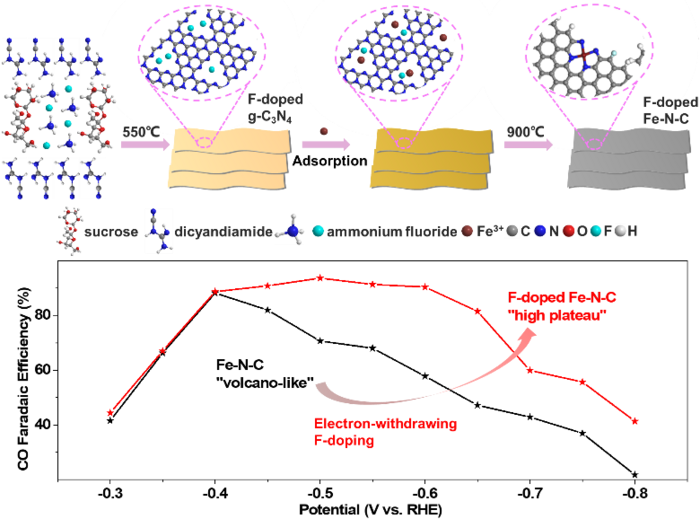Excess carbon dioxide emissions have resulted in climate difficulties and greenhouse effects as the industry has evolved over the last century. Scientists are continually attempting to find answers to the problems associated with greenhouse gases, which are warming the earth’s surface and lower atmosphere. Carbon dioxide is the most common greenhouse gas.
 The F-doped Fe-N-C single-site catalyst maintains the advantage of low overpotential for Fe-N-C, with much increased CO faradaic efficiency and partial current density due to the stabilized Fe3+ active sites by electron-withdrawing F-doping. Image Credit: Nano Research.
The F-doped Fe-N-C single-site catalyst maintains the advantage of low overpotential for Fe-N-C, with much increased CO faradaic efficiency and partial current density due to the stabilized Fe3+ active sites by electron-withdrawing F-doping. Image Credit: Nano Research.
Using electrical energy supplied from the wind or the sun, carbon dioxide may be electrochemically converted into useful chemicals. This method of carbon dioxide electroreduction offers scientists a viable option for maintaining the global carbon balance.
Electrochemical carbon dioxide reduction has the potential to transform carbon dioxide into usable, ecologically friendly compounds like carbon monoxide, methane, or ethanol in the future. Scientists require effective electrocatalysts to conduct carbon dioxide electroreduction.
Catalysts for electrochemical processes are known as electrocatalysts. They can speed up the reaction. Nanjing University researchers have developed catalysts with improved performance thanks to a fluorine doping approach.
On May 1st, 2022, the study team published their findings in the journal Nano Research.
Carbon dioxide electroreduction to carbon monoxide works effectively using low-cost metal-nitrogen-carbon single-site catalysts, according to scientists. The nickel-nitrogen-doped carbon single-site catalysts have a high carbon monoxide faradaic efficiency and a significant partial current. In an electrochemical process, the faradaic efficiency indicates how effectively the charge is transported.
By doping nickel-nitrogen-doped carbon single-site catalysts, the study team has already increased their faradaic efficiency and huge partial current. Iron-nitrogen-carbon single-site catalysts exhibit lower overpotentials for carbon dioxide electroreduction than nickel-nitrogen-doped carbon single-site catalysts. The voltage efficiency of a cell is described by its overpotential.
X-Ray absorption fine structure spectroscopy was utilized in the previous study to confirm that the active sites of the iron-nitrogen-carbon single-site catalysts are Fe3+ sites. These Fe3+ sites make the catalyst more effective in the adsorption and desorption of carbon dioxide and carbon monoxide.
As predicted, the study team created a fluorine-doped iron-nitrogen-carbon single-site catalyst with more Fe3+ sites. They were able to keep the low overpotential of the fluorine-doped iron-nitrogen-carbon single-site catalyst they built. It also helped to raise the carbon monoxide faradaic efficiency from a crater-like peak to a high plateau.
The results indicate the superior stability of fluorine-doped iron-nitrogen-carbon to iron-nitrogen-carbon because of the fluorine-doping.
Lijun Yang, Associate Professor, School of Chemistry and Chemical Engineering, Nanjing University
Due to the stable Fe3+ sites, the study team believes that electron-withdrawing fluorine doping permits the iron-nitrogen-carbon single-site catalyst to preserve its low overpotential, with a significantly higher carbon monoxide faradaic efficiency and partial current density.
The iron-nitrogen-carbon was created utilizing a thermal process known as adsorption pyrolysis. Researchers used an H-type cell and a gas diffusion electrode cell to conduct the carbon dioxide electroreduction studies. Scientists performed theoretical simulations to have a better understanding of the fluorine doping benefits.
Electrochemical tests show the enriched defects by fluorine-doping kinetically increase the electroactive surface area and improve charge transfer.
Lijun Yang, Associate Professor, School of Chemistry and Chemical Engineering, Nanjing University
In terms of future research, the findings present a straightforward and controlled technique for improving the carbon dioxide electroreduction to carbon monoxide efficiency of iron-nitrogen-carbon catalysts by stabilizing the Fe3+ sites.
Yiqun Chen, Yu Zeng, Lijie Yan, Xizhang Wang, Guochang Li, Lijun Yang, Qiang Wu, and Zheng Hu from Nanjing University are part of the study team.
The research is supported by China’s National Key Research and Development Program, China’s National Natural Science Foundation, Jiangsu Province’s Natural Science Foundation, Major Project, and Nanjing University’s Ph.D. candidate Innovation Program.
Journal Reference:
Chen, Y., et al. (2022) Boosting faradaic efficiency of CO2 electroreduction to CO for Fe−N−C single-site catalysts by stabilizing Fe3+ sites via F-doping. Nano Research. doi.org/10.1007/s12274-022-4441-0.